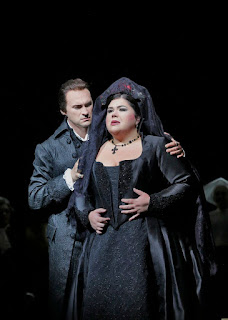OPERA
Santa Fe Opera
The Crosby Theatre, Santa Fe
RODNEY PUNT
Santa Fe Opera
The Crosby Theatre, Santa Fe
RODNEY PUNT
Don Giovanni
rivals The Marriage of Figaro as the
greatest opera Mozart ever wrote. Yet it is only his fourth most-performed at the Santa Fe Opera, ranking after the enormously popular Figaro and Magic Flute, as well as (by virtue of its small cast) the economical Cosi fan tutte. After seven years, a new production revived Giovanni's cautionary tale on seduction, with a droll feel less "dramma giocoso" than the "opera buffa" Mozart himself tagged it. The Don's comeuppance bursts with comic energy, and though its amorality is admittedly dark, it's still cousin to that other salacious comedy, Falstaff.
After the claustrophobic sets of season opener Fanciulla del West, this one took place without much architecture save a large and effective centerpiece. Designer Riccardo Hernandez's massive bronze-glazed female head of flowing hair ascends early in the action from the end of the stage and draws forward and back during the proceedings -- a female dopplegänger keeping a judgmental eye always focused. Peter Nigrini's colorful projections emphasize its role as obsessive totem, a twisted version of the “eternal feminine” in Goethe’s Faust. When the Don’s fiery punishment approaches, the head transforms into a blood-red skull. The eternal feminine becomes an infernal feminine. That which attracts can just as easily kill.
 |
| Montvidas (Ottavio) and Crocetto (Anna) |
The evening's action was framed on both sides of the stage with black Mylar and opened in the back to the New Mexican landscape, with little scenery other than Don Giovanni's boudoir bathtub and, in the penultimate scene the graveyard statues. As evening darkness descended on Santa Fe, its vast emptiness mirrored the existential void of Giovanni’s depraved world, particularly so in the final scene when the Don dines -- and dies -- alone.
Director Ron Daniels relied more on his well balanced cast of singing actors for credible character delineation than sets and props. A certain suspension of disbelief was required, but the near empty stage liberated movement for all, most tellingly for the libertine. The salacious Giovanni juggled simultaneous amatory intrigues in exposed corners as others pursued him and the much put upon
Leporello covered for his actions.
Adding hyper-real luxuriance were Marcus Doschi’s lighting projections and Emily Rebholz's sumptuous costumes, color-coded to reflect the moods of each of the protagonists and shimmering in stark contrast to the pitch black stage.
Adding hyper-real luxuriance were Marcus Doschi’s lighting projections and Emily Rebholz's sumptuous costumes, color-coded to reflect the moods of each of the protagonists and shimmering in stark contrast to the pitch black stage.
 |
| Alkema (Elvira) and Ketelsen (Leporello) |
The singing throughout was superb, well balanced between the
principals and consistently stylish. Tall and handsome, Daniel Okulitch’s Don
Giovanni, initially dressed in heartless black but later in devil-red and brimming with callous ego, was to his mellifluous seductive manner born. Sporting a naked torso, the Don bathed in a
bathtub while eagerly chatting about his next conquest. Kyle Ketelsen’s dark and
smoky bass squirmed, protested, and spit metaphoric nails in the best carping Leporello manner, especially when his master insisted they exchange outfits.
Leah Crocetto’s vocally nimble Donna Anna and her fiancé,
the Don Ottavio of elegant tenor Edgaras Montvidas, were decked out in funereal
black, mourning the fate of her late father. Solomon Howard's Commendatore was the tallest and most fearsomely stentorian at his second coming of any this reviewer has encountered. Keep an eye and an ear out for future engagements of this singer.
Keri Alkema’s jilted Donna Elvira, still stuck on the Don, sported envy-green as she doggedly pursued him at every virtuoso turn. The virtuosic fioritura of the two Donnas and Ottavio were models of style. Only the latter’s “Il mio Tesoro” moved at perhaps too rapid a pace for full vocal comfort.
Keri Alkema’s jilted Donna Elvira, still stuck on the Don, sported envy-green as she doggedly pursued him at every virtuoso turn. The virtuosic fioritura of the two Donnas and Ottavio were models of style. Only the latter’s “Il mio Tesoro” moved at perhaps too rapid a pace for full vocal comfort.
 |
| Rhine Lois (Zerlina) and Ensemble |
Dressed in virginal white for her wedding, Rhian Lois’s
Zerlina was perfection as the petite peasant girl of good, if somewhat pliable
morals under the Don’s seductive tutelage. Jarrett Ott’s much put upon Masetto, betrothed defender
of male peasant virtue to his Zerlina, seemed a little too easily hoodwinked by her as he good-naturedly bestowed his forgiveness.
Veteran John Nelson maintained fine classical momentum in the
orchestra. As called for in Mozart’s score, a woodwind and brass contingent felicitously performed the dance sequences on stage.
This was an inventive, handsome, and worthy Don Giovanni to round out six decades of Mozartian elegance and élan at the Santa Fe Opera.
This was an inventive, handsome, and worthy Don Giovanni to round out six decades of Mozartian elegance and élan at the Santa Fe Opera.


No comments:
Post a Comment
Note: Only a member of this blog may post a comment.